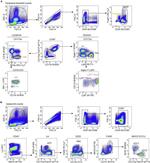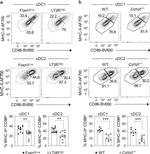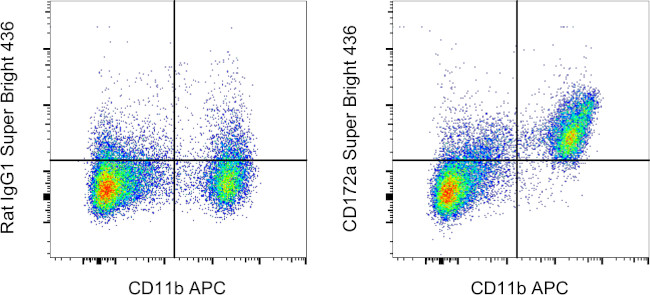Search Thermo Fisher Scientific
Invitrogen
CD172a (SIRP alpha) Monoclonal Antibody (P84), Super Bright™ 436, eBioscience™
FIGURE: 1 / 3
CD172a (SIRP alpha) Antibody (62-1721-82) in Flow



Product Details
62-1721-82
Species Reactivity
Published species
Host/Isotype
Recommended Isotype Control
Class
Type
Clone
Conjugate
Excitation/Emission Max
Form
Concentration
Purification
Storage buffer
Contains
Storage conditions
Shipping conditions
RRID
Product Specific Information
Description: This P84 monoclonal antibody reacts with mouse CD172a, also known as signal regulatory protein a (SIRPa). This cell surface glycoprotein consists of three Ig-like extracellular domains and two cytoplasmic immunoreceptor tyrosine-based inhibitory motifs (ITIMs). The ITIM domains have been demonstrated to recruit and bind the Src homology 2 domain-containing phosphatases SHP-1 and SHP-2. CD172a is expressed on monocytes, macrophages, dendritic cells, but not on T and B lymphocytes. Moreover, neurons and other tissues of the central nervous system have also been shown to express CD172a. The integrin-associated protein CD47 is the extracellular ligand for CD172a. Studies show that CD172a is involved in dendritic cell-mediated T cell activation, neutrophil migration, and phagocytosis.
This monoclonal antibody has been reported to have neutralizing activity.
Applications Reported: This P84 antibody has been reported for use in flow cytometric analysis.
Applications Tested: This P84 antibody has been tested by flow cytometric analysis of mouse bone marrow cells. This may be used at less than or equal to 1.0 µg per test. A test is defined as the amount (µg) of antibody that will stain a cell sample in a final volume of 100 µL. Cell number should be determined empirically but can range from 10^5 to 10^8 cells/test. It is recommended that the antibody be carefully titrated for optimal performance in the assay of interest.
Super Bright 436 can be excited with the violet laser line (405 nm) and emits at 436 nm. We recommend using a 450/50 bandpass filter, or equivalent. Please make sure that your instrument is capable of detecting this fluorochrome.
When using two or more Super Bright dye-conjugated antibodies in a staining panel, it is recommended to use Super Bright Complete Staining Buffer (Product # SB-4401) to minimize any non-specific polymer interactions. Please refer to the datasheet for Super Bright Staining Buffer for more information.
Excitation: 405 nm; Emission: 436 nm; Laser: Violet Laser
Super Bright Polymer Dyes are sold under license from Becton, Dickinson and Company.
Target Information
SIRP alpha (CD172a, signal-regulatory protein alpha) is a receptor-type transmembrane glycoprotein expressed on cells of myeloid origin, including granulocytes, dendritic cells (DCs), macrophages, mast cells and hematopoietic stem cells. SIRP alpha acts as a substrate for several activated tyrosine kinases, including EGFR, PDGFR, src and insulin receptor and is involved in the negative regulation of receptor tyrosine kinase-coupled signaling pathways. The ligand binding of SIRP alpha to integrin-associated protein CD47 results in tyrosine kinase phosphorylation of immunoreceptor tyrosine-based inhibitory motifs (ITIMs) within the cytoplasmic region of SIRP alpha, which mediates the recruitment and activation of the tyrosine phosphatases SHP-1 and SHP-2. Ligation of SIRP alpha with CD47 has been demonstrated in several regulatory processes, including the inhibition of host cell phagocytosis by macrophages and the bi-directional activation of T cells and DCs. SIRP alpha has regulatory effects on cellular responses induced by serum, growth factors, insulin, oncogenes, growth hormones and cell adhesion, and plays a general role in different physiological and pathological processes. Cancer cells highly express CD47, which activates SIRP alpha and inhibits macrophage-mediated destruction of cancerous cell growth.
For Research Use Only. Not for use in diagnostic procedures. Not for resale without express authorization.
How to use the Panel Builder
Watch the video to learn how to use the Invitrogen Flow Cytometry Panel Builder to build your next flow cytometry panel in 5 easy steps.
Bioinformatics
Protein Aliases: Bit; Brain Ig-like molecule with tyrosine-based activation motifs; brain immunological-like with tyrosine-based motifs; CD172 alpha; CD172 antigen-like family member A; CD172a; Inhibitory receptor SHPS-1; mSIRP-alpha1; MyD-1 antigen; p84; protein tyrosine phosphatase, non-receptor type substrate 1; SHP substrate 1; Signal-regulatory protein alpha-1; Sirp-alpha-1; SIRPalpha; SIRPalpha2; Tyrosine-protein phosphatase non-receptor type substrate 1
Gene Aliases: AI835480; Bit; CD172a; Myd1; P84; Ptpns1; SHP-1; SHPS-1; Shps1; SIRP; Sirpa
UniProt ID: (Mouse) P97797
Entrez Gene ID: (Mouse) 19261

Performance Guarantee
If an Invitrogen™ antibody doesn't perform as described on our website or datasheet,we'll replace the product at no cost to you, or provide you with a credit for a future purchase.*
Learn more
We're here to help
Get expert recommendations for common problems or connect directly with an on staff expert for technical assistance related to applications, equipment and general product use.
Contact tech support

